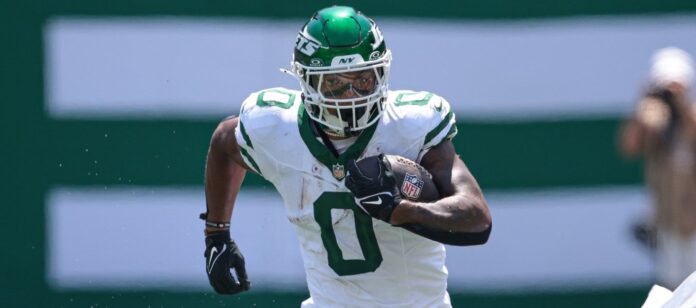At first glance, not drafting a running back until the later rounds of fantasy football drafts can be a terrifying strategy. After all, seven of the top 10 Flex scorers last season were running backs. Of the top 24 scorers last season, 16 were running backs. So why use a Zero RB strategy?
Every year, it appears to be a coin flip if receivers or running backs take the driver’s seat. In 2023, only four of the top 10 scorers were backs, and only 10 made the top 24. A Zero RB strategy is a relatively bold strategy that can hit big in seasons where injuries plague the position. Unlike receivers, when a back goes down, there is often a clear player who steps into the role. In this article, I am going to break down how I approach this strategy and construct my roster for the 2025 season.
Zero RB Fantasy Football Draft Strategy
Opening Rounds
Often, you don’t choose a Zero RB strategy; the strategy chooses you. What I mean by this is that you can’t enter your draft expecting to implement this approach. To truly capitalize on the strategy, you need the draft to come to you. Having the confidence and knowledge to execute a Zero RB strategy correctly is another feather in your cap to be a fluid drafter. A fluid drafter takes advantage of those they are drafting with, often capitalizing on values and strong roster construction.
It’s always important to hit on your early round picks, and Zero RB is no different. If you let the draft come to you, you will likely have an incredible one-two stack at the wide receiver position. Typically, I like to pair a high upside receiver with a high volume receiver at the top of my draft. The top receivers are all great, but some are more consistent than others. For example, if I draft Brian Thomas Jr. or Nico Collins, I’d rather pair them with a volume play — either Amon-Ra St. Brown or Drake London — rather than with each other. If you are picking at the top of your draft and get Ja’Marr Chase, Justin Jefferson or CeeDee Lamb, approach your second and third picks with the same upside and volume pairing.
If you can leave the first two rounds with a pair, something like Collins and St. Brown/Chase and Ladd McConkey, you are flying.
Difference-Makers
If you decide to “punt” a position, it’s a huge advantage to draft positional difference-makers. These players are the top quarterbacks and top tight ends. Typically, if you draft both of these positions early, it’s tough to round out your roster. However, if you are utilizing a Zero RB approach and you can get value on both of these top-end positions, it is very manageable to draft both.
Why draft these players early? Last year, the top three tight ends, Brock Bowers, George Kittle and Trey McBride, all scored nearly two more fantasy points per game than the TE4.
Before we talk about the quarterback position, I need you to buckle up. Lamar Jackson scored 50 more fantasy points than QB2 Josh Allen. That’s roughly a three-point advantage each week and over 100 points (~six points per game) more than the QB6on the season. While the top quarterbacks last season included names such as Baker Mayfield and Joe Burrow, it’s tough for these pocket passers to reach the heights of Jackson’s 2024 season.
The difference-makers at quarterback are Jackson, Allen, Jayden Daniels, Jalen Hurts and Burrow. Burrow is on the fringe of that tier, but if you pair him with Bowers or McBride, that’s a powerful duo. That leads me to the difference-makers at tight end. I believe these are Bowers, McBride and Kittle. Kittle is similar to Burrow — if he is paired with one of the other quarterbacks, it’s an elite combination. Between these positional stars, you can gain the ground you’ll be losing at running back, plus you will likely still have an advantage at wide receiver.
Middle Round Receivers
These picks are the ones that can truly take this strategy to the next level. If you can hit on these players and manage to have three or four receivers in the top 20 on the season, it’ll be hard not to make the playoffs.
With this strategy, I prefer to focus on players projected to have steady volume, rather than those with volatile, spike weeks. I take this approach as I expect to ride the elite upside of my first two receivers and difference-makers to provide the ceiling advantage. As a result, players who have upside, but also safe floors, are great for filling out your WR3 or Flex options.
For me, these names are often a combination of DJ Moore, Courtland Sutton, Tetairoa McMillan and Calvin Ridley. In comparison, I will avoid players with similar profiles to Jameson Williams, DeVonta Smith and DK Metcalf.
To put this all together, based on current average draft position (ADP) and picking at the 1.01, a Zero RB build could look like this through six rounds:
Zero RB to Full RB
Once you reach roughly round seven or eight, it’s time to take your first running back. There are Zero RB builds that go well into the double-digit rounds before selecting a back. However, my opinion is that once the other positions on your starting roster are complete, you need to start looking at running back. After all, you can have great bench receivers, but they will all score the same amount for you each week — zero.
This year, drafts are structured perfectly to take a running back at this point in the draft, with multiple starters going between picks 70 and 90. These names include: James Conner, RJ Harvey, Kaleb Johnson, Quinshon Judkins, D’Andre Swift, Tony Pollard, Aaron Jones, Isiah Pacheco and Brian Robinson Jr. If you can get two of these players, you will have a very steady roster. Of this list, I would emphasize volume over upside, as you will be relying on your earlier picks for weekly upside. For example, I would target Johnson over Harvey and Pollard over Swift.
You need to select these backs with the same energy as the Flex Seal guy. OK, maybe not the same energy, but you are metaphorically doing the same thing. Going this far without a back, you are on a boat taking on water. These players need to seal the leak and keep it afloat. That’s why I prioritize volume over upside for these picks.
The Unhinged Ceiling of Zero RB
The selections mentioned above probably killed your buzz on the whole Zero RB strategy. After all, it’s hard to get Flex Seal excited about seeing Kaleb Johnson and Tony Pollard as your RB1 and RB2. That’s where late-round running backs can take your team to another level.
As I hinted in the introduction, running backs often have a clear player to step up in case of injury. Historically, these backs aren’t a complete one-for-one replacement when it comes to fantasy value; however, they can often provide 80% of the production the starter received. This is how some managers hit big on the rookie seasons of Alvin Kamara, James Robinson and Pacheco. If you happen to find this year’s equivalent while drafting a Zero RB build, you have struck gold.
One of the easiest ways to identify these players is to find rookies in ambiguous situations. This year, the top suspects are Bhayshul Tuten, Cam Skattebo and Kyle Monangai. Taking a swing at these players can hit big; however, multiple players rarely work out in a single season. As a result, don’t over-commit to multiple swings, and select the specific few you believe in the most.
The flipside of these ambiguous backfields is to select veterans who are undervalued due to age or potential competition. For example, Jaylen Warren, Travis Etienne, Austin Ekeler, Jordan Mason and Tyrone Tracy Jr. could all outproduce their backfield partners without much surprise. Some veterans may share the work but still provide weekly value, such as J.K. Dobbins and Jaylen Wright. Mixing these players with high upside rookie shots will provide optimal ability to hit big.
The third group of late-round backs to target are the clear backups. These players are less enjoyable to discuss, as they provide value at the expense of the starter missing time. It’s never fun to draft for injury, yet it has to be recognized that injuries are part of football, especially at the running back position. It’s impossible to predict injury, but it is possible to draft backs that will take over the full workload if the starter goes down. The gold standard of these players in the late rounds would be the likes of Tyler Allgeier, Braelon Allen and Isaac Guerendo. If any of the starters ahead of them miss time, you can plug and play these players as weekly must-starts in their absence.
In the end, on a typical 15-round roster, I would try to have six or seven running backs. These backs are a mix of undervalued veterans, high upside rookies and ambiguous backfields. You can build a solid roster using this strategy, but the championship upside comes from taking multiple shots on these later backs.
Subscribe: YouTube | Spotify | Apple Podcasts | iHeart | Castbox | Amazon Music | Podcast Addict | TuneIn


